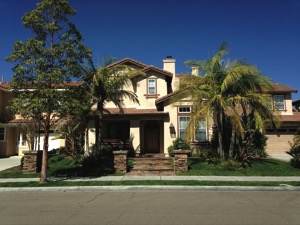
For those of you lucky to have an outdoor space or two to design, the pleasures are great but the challenges many. It takes money, care and most importantly, thought, to design a garden that is beautiful yet does not gobble up too many resources and is relatively easy to maintain. For those of us in drought plagued areas like San Diego, our circumstances do limit our choices, but planning wisely will bring great results.
First, some basic ideas to keep in mind. The same principles apply when designing a garden or any work of art. We need to think about color, texture and composition. With such a vast variety of plants to choose from, we can select a personal palette. To amplify interest, think of mixtures of species— grasses, cacti, perennials and ground covers to include in your garden.
The ground may be flat but you can create an interesting topography with berms and rocks. Remember to think of how to direct whatever rainfall may occur into your water-wise design. Using nature and then enhancing it is the key to a successful garden. You can create levels with your plan and also with the plants you choose, adding height and volume with trees and shrubs.
It is wise to select plants that are drought resistant and local varieties that are adapted to soil and climate. These plants are hardy and rarely require additional fertilizers and pest controls. Be cognizant of each plant’s requirement for sun or shade and place them appropriately. Limit turf grasses as these require significant water and choose native grasses instead.
In designing your garden composition, think big to small. Trees should be selected and planted first, as they are not to be moved and are foundational to your space. Remember not to place them too close to the house; four feet away would be the minimum. These distance considerations should be made for patios, decks and swimming pools too. You don’t want to compromise the structure of these elements.
When selecting plants at the nursery, be mindful of their appropriate climate zone, how large they are likely to grow, the soil they will need to thrive. If you decide to incorporate bamboo, be aware of the different types and their tendency to grow fast and wild, possibly overwhelming your yard.
Your garden will likely attract wildlife, some welcome, some not. If you’d like hummingbirds, bees and butterflies to stop by, select those plants that will attract them. To deter unwelcome visitors, make sure fences cannot be breached. If you’d like to enjoy your garden in the evening, make sure to incorporate lighting into your design.
Your garden can be magnificent or it can be a sorry mess. Overall, the most important factor is water. The need for lots of water can be mitigated by making the right choices of water-resistant plants, and making the most of the water we do get, with correct placement and water catchment systems. With proper planning, even water-starved areas like our own can produce stunning verdant spaces.
Start digging and good luck landscapers!











